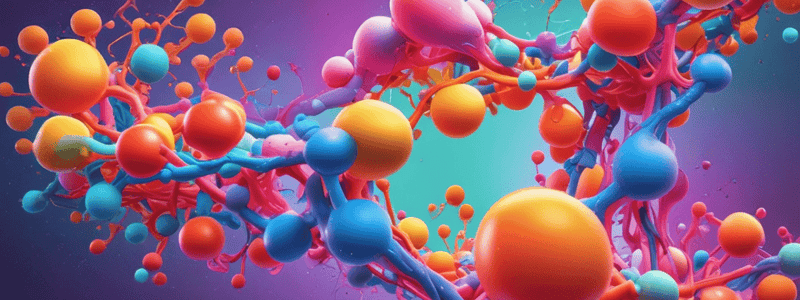Podcast
Questions and Answers
Which of the following is a function of amino acids?
Which of the following is a function of amino acids?
- Regulating the immune system
- Producing body peptides and proteins (correct)
- Forming fatty acids
- Generating electricity
Which type of hormone is not formed from amino acids?
Which type of hormone is not formed from amino acids?
- Peptide hormones
- Thyroid hormones
- Steroid hormones (correct)
- Amine hormones
What is the process called when an amino acid is converted into an amine?
What is the process called when an amino acid is converted into an amine?
- Acetylation
- Oxidation
- Decarboxylation (correct)
- Hydroxylation
Which of the following is an example of an amine derived from an amino acid?
Which of the following is an example of an amine derived from an amino acid?
Which of the following is a function of the amino acid histidine?
Which of the following is a function of the amino acid histidine?
What type of protein is thyroid-stimulating hormone (TSH)?
What type of protein is thyroid-stimulating hormone (TSH)?
Which of the following amino acids is considered essential?
Which of the following amino acids is considered essential?
What is the classification of proteins based on their function?
What is the classification of proteins based on their function?
Which of the following amino acids is considered partially essential?
Which of the following amino acids is considered partially essential?
Which of the following proteins is an example of a transport protein?
Which of the following proteins is an example of a transport protein?
Which of the following is an example of a regulatory protein?
Which of the following is an example of a regulatory protein?
How many amino acids are considered non-essential?
How many amino acids are considered non-essential?
Which of the following statements about simple proteins is correct?
Which of the following statements about simple proteins is correct?
Which of the following is a characteristic of globulins?
Which of the following is a characteristic of globulins?
Which of the following statements about glycoproteins is incorrect?
Which of the following statements about glycoproteins is incorrect?
What is the primary function of lipoproteins?
What is the primary function of lipoproteins?
Which of the following is an example of a chromoprotein?
Which of the following is an example of a chromoprotein?
What is the primary difference between simple proteins and conjugated proteins?
What is the primary difference between simple proteins and conjugated proteins?
What is the defining characteristic of aliphatic amino acids?
What is the defining characteristic of aliphatic amino acids?
Which amino acids are examples of aromatic amino acids?
Which amino acids are examples of aromatic amino acids?
Which functional group defines an imino acid?
Which functional group defines an imino acid?
Which amino acid is classified as an imino acid?
Which amino acid is classified as an imino acid?
What is the difference between amino acids and imino acids?
What is the difference between amino acids and imino acids?
Which enzyme is responsible for converting amino acids into imino acids?
Which enzyme is responsible for converting amino acids into imino acids?
Which category of amino acids includes Tryptophan and Histidine?
Which category of amino acids includes Tryptophan and Histidine?
Which amino acid is classified as a dibasic monocarboxylic acid?
Which amino acid is classified as a dibasic monocarboxylic acid?
Which of the following amino acids is considered hydrophobic and lipophilic?
Which of the following amino acids is considered hydrophobic and lipophilic?
Which of the following amino acids is considered hydrophilic due to its uncharged or nonionic polar side chain?
Which of the following amino acids is considered hydrophilic due to its uncharged or nonionic polar side chain?
Which of the following amino acids is considered purely ketogenic?
Which of the following amino acids is considered purely ketogenic?
Which of the following amino acids is considered both ketogenic and glucogenic?
Which of the following amino acids is considered both ketogenic and glucogenic?
Which of the following amino acids has a positive charge on its R group, making it a basic amino acid?
Which of the following amino acids has a positive charge on its R group, making it a basic amino acid?
Which of the following amino acids is considered mildly acidic?
Which of the following amino acids is considered mildly acidic?
Flashcards are hidden until you start studying
Study Notes
Functions of Amino Acids
- Body peptides and proteins: plasma protein, tissue protein, enzyme, antibody, receptor, etc.
- Hormones: some hormone polypeptide (TSH, LH, FSH, GH) and other amino acid derivatives (T4)
- Amines: some amino acids give amines by decarboxylation (e.g., histidine gives histamine, a vasodilator)
Classification of Amino Acids Based on Nutritional Requirements
- Essential amino acids: cannot be made by the body and must be taken in through food for normal growth
- Isoleucine, Leucine, Threonine, Lysine, Methionine, Phenylalanine, Tryptophan, and Valine
- Partially essential (semi-essential) amino acids: Histidine and Arginine
- Non-essential (dispensable) amino acids: can be made by the body, including 10 amino acids
Classification of Proteins Based on Function
- Catalytic proteins: enzymes
- Structural proteins: collagen, elastin
- Contractile proteins: myosin, actin
- Transport proteins: hemoglobin, myoglobin, albumin, transferrin
- Regulatory proteins or hormones: ACTH, insulin, growth hormone
- Genetic proteins: histones
- Protective proteins: immunoglobulins, interferons, clotting factors
Classification of Proteins Based on Composition and Solubility
- Simple proteins: contain only amino acids
- Albumin: soluble in water, coagulated by heat
- Globulins: insoluble in pure water, but soluble in dilute salt solutions
- Conjugated proteins: combinations of protein with a non-protein part (prosthetic group)
- Glycoproteins: combined with carbohydrates
- Lipoproteins: loosely combined with lipid components
- Nucleoproteins: attached to nucleic acids
- Chromoproteins: proteins with colored prosthetic groups
Classification of Amino Acids
- Based on Structure
- Aliphatic amino acids: contain no ring
- Aromatic amino acids: contain phenyl or phenol rings (e.g., Phenylalanine, Tyrosine)
- Heterocyclic amino acids: contain other types of rings (e.g., Tryptophan, Histidine)
- Imino acid: contains imine (NH) and carboxyl (COOH) functional groups (e.g., Proline)
Classification of Amino Acids Based on Side Chain
- Amino acids with nonpolar side chains: Alanine, Valine, Leucine, Isoleucine, Aromatic amino acids, Methionine, Proline, Phenylalanine, and Tryptophan (hydrophobic and lipophilic)
- Amino acids with uncharged or nonionic polar side chains: Glycine, Serine, Threonine, Cysteine, Tyrosine, Glutamine, and Asparagine (hydrophilic)
- Amino acids with charged or ionic polar side chains: acidic (Aspartic acid, Glutamic acid) or basic (Lysine, Arginine, Histidine) (hydrophilic)
Classification of Amino Acids Based on Metabolic Fate
- Purely ketogenic: Leucine & Lysine (converted to ketone bodies)
- Ketogenic and glucogenic: Isoleucine, Phenylalanine, Tyrosine, Threonine, and Tryptophan
Studying That Suits You
Use AI to generate personalized quizzes and flashcards to suit your learning preferences.




